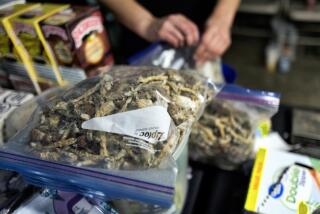Cancer Hokum Wastes Vital Time, Specialists Tell Symposium at Hoag : Medicine: Half of U.S. cancer patients die, so ‘people will continue to gravitate to unproven prescriptions,’ expert says.
- Share via
In Newport Beach, a man who needed surgery for colon cancer told his startled doctor that he would be taking “macrobiotic therapy” instead.
In San Diego, a cancer clinic has been “protecting” patients against their disease by inoculating them with a “vaccine” made from their own urine.
And in Tijuana, doctors are treating cancer patients with coffee enemas and juice made from “pressed calves’ liver.”
As long as half the nation’s cancer patients continue to die, “people will continue to gravitate to unproven prescriptions” such as these, UC San Diego oncologist Mark R. Green told 50 doctors and nurses Saturday at a symposium sponsored by the Hoag Hospital Cancer Center.
Across the nation, 1 million people are diagnosed with cancer each year and 500,000 die from it--about 5,000 in Orange County, said Dr. Robert O. Dillman, the cancer center’s medical director.
Green, who has investigated some of the purported cures, said he tries not to argue with his patients about the efficacy of an unorthodox remedy.
And, he said, he is “willing to provide conventional cancer therapy to someone taking another, unconventional therapy.”
Still, he urged doctors “to talk about the science, if there is any science,” behind an unorthodox remedy and try to explain why such treatment will not work.
Green said he understood the feeling of helplessness that drives many cancer patients to seek unusual treatment. And citing a University of Pennsylvania study of cancer patients, he noted that such alternatives are common.
In that study, 325 of 660 patients reported taking both conventional and “alternative” cancer therapies--megavitamins, special diets, faith healing and the like, Green said. Another 58 took “alternative” cancer therapies only. But “many people covered their bets,” he said, enrolling in several “alternative” therapies at the same time.
Surprisingly, private health insurance paid for many of the unorthodox treatments, Green added, because “two-thirds or more of those purveying this in the U.S. are licensed doctors.”
He described varied unproven cancer cures: macrobiotic therapies in which practitioners seek to purge the cancer through a diet of whole grains and vegetables; infusion of Laetrile, which is made from apricot or cherry pits, and ingestion of large quantities of Vitamin C.
“My mother, when I have a cold, says, ‘Take Vitamin C.’ And I do,” Green said. “But I don’t prescribe Vitamin C to my patients for cancer!”
One of Green’s complaints about alternate therapies is that their practitioners often blame the patient when the cancer spreads. At one Tijuana clinic, they say, ‘If your disease progresses, it’s because you did the therapy wrong,” Green recounted.
Also, some unorthodox remedies are toxic and may make the patient sicker; for instance, patients who receive Laetrile risk bacteria infection and cyanide poisoning, he said.
And Green said he becomes very upset when a patient who could have been helped rejects conventional therapy for worthless treatment.
“When someone comes in with . . . head-to-toe tumors, I mean you could just cry,” he said.
For all that, Green said, he does not object when a patient uses “visual imagery,” along with conventional therapies, to try to fight his cancer.
“I think everybody ought to have a good attitude. If you want to imagine something Pac-manning away a tumor, that’s OK,” Green said.






